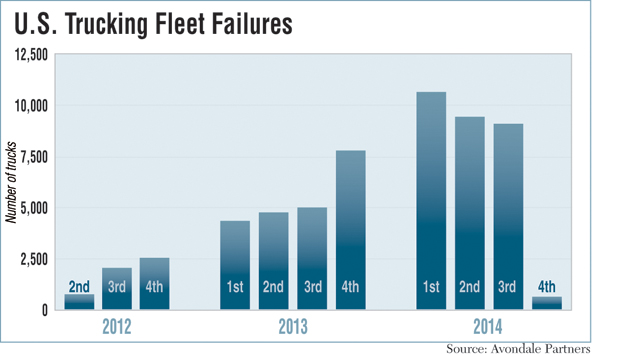Fleet Failures at Record Low as Rates Rise, Fuel Declines
 By Rip Watson, Senior Reporter
By Rip Watson, Senior Reporter This story appears in the Jan. 26 print edition of Transport Topics.
Fleet failures plummeted to an all-time low in the fourth quarter as higher rates and lower fuel prices pumped cash into the fleets that were in danger of failing, a new report said.
Avondale Partners analyst Donald Broughton told Transport Topics a total of 605 trucks were pulled from the road last quarter. That was fewer than the previous low of 725, set in second quarter of 2012, and a precipitous drop from the 9,090 trucks in fleets that failed in the third quarter.
The tally was 7,775 in last year’s fourth quarter.
Broughton, who has tracked trucking failures since 1990, cited several revival factors. They included tighter capacity that triggered rate increases, improved weather that added miles and lower diesel prices. Trucking’s main fuel dipped 52 cents per gallon, or 14%, during the fourth quarter, according to the U.S. Energy Department.
“When you give a trucking company higher rates, more miles, better margins and stronger cash flow, that pumps lifeblood into a trucking company that otherwise would have been terminally ill,” Broughton said.
The drop-off was sharpest from the first quarter of last year, when rising costs tied to weather and fuel pushed 10,650 trucks off the road. Last year’s failures totaled 29,780, or 36%, more than 2013.
Broughton believes diesel, which fell below $3 per gallon on average last week, is likely to continue dropping for the foreseeable future.
While continued declines will keep fleets alive, Broughton believes the real test will come when fuel flattens out for two consecutive quarters.
“When that happens, we will get to see who was healed by the cash flow enhancement and whose death spiral was just being prolonged,” Broughton said.
Lower fuel prices are having another effect by driving some freight back to trucking and away from intermodal, said Broughton and Bob Costello, American Trucking Associations’ chief economist.
“We believe some — not a lot of — intermodal freight is moving to the highway due to much lower diesel prices,” Costello told TT. “However, that is limited from capacity constraints in the truckload sector.”
”When — not if — diesel eventually goes back up, the opposite will be true — more freight will go back to rail intermodal,” he said.
Broughton believes lower fuel costs will help truckers capture a significant number of freight moves in the 550- to 650-mile range. Dropping diesel prices give all-highway moves a cost advantage over intermodal for runs as far as 650 miles, compared with a 550-mile distance when diesel was pushing $4 a gallon last year.
Others don’t agree with that assessment. Among them is Mark Yeager, president of Hub Group Inc., which generates about $2.5 billion in intermodal freight annually.
He spoke this month at the Transportation Research Board’s annual meeting, where he said conversions of freight to intermodal from highway continue over shorter distances because of tight trucking capacity.
Unlike other analysts, such as John Larkin of Stifel Nicolaus and consultant FTR’s Noel Perry, a former truckload executive, Broughton isn’t worried about tight capacity.
“We are going to grow capacity,” Broughton said.
“Capacity is not going to shrink through failures because they are declining,” he said.
Last month’s congressional action that changed the hours-of-service rest-period requirements should boost capacity by 2% to 2.5%, Broughton noted.
Higher profits will spur more pay increases, he believes. A National Transportation Institute report late last year said 42% of truckload fleets announced pay raises during the third quarter, nearly quadruple the previous quarterly high.
Broughton sees plenty of room for pay increases between the $40,000 for a driver who’s on the road three weeks at a time and a less-than-truckload driver who makes $90,000, he said, and is home every night.
“If the biggest truckload carriers out there said they were willing to pay $85,000 and get drivers home every night, they could easily triple the size of their fleet,” he said.
Broughton said the few fourth-quarter failures resulted from mandated use of electronic logging devices after safety inspections, which constrained fleets’ ability to capitalize on market advantages.
Broughton cited multiple factors to buttress his market analysis.
He noted that all Web-based load boards routinely showed five or six loads for each available truck. In addition, ATA’s tonnage and freight volume reports signaled solid demand growth.
Load board operator DAT reported record rates in December, including the effect of lower diesel prices that adjusted fuel surcharges. A truckload pricing index compiled by Avondale and Cass Information Systems also showed rates peaking late last year.
The Avondale analyst chronicled other fuel-related advantages fleets enjoy when prices drop.
Fleets collect fuel surcharge revenue on a higher price than they are actually paying at the pump.
Lenders helped, too.
“Banks and other lenders that were looking to shut you down quickly before saw a dramatically improved financial picture, and they backed off,” he said.
Seth Clevenger contributed to this report.

